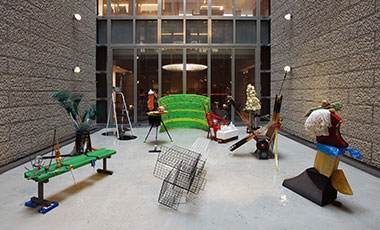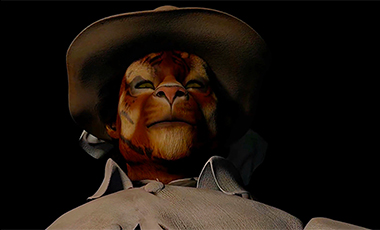Various Korean art exhibitions open in France this year in commemoration of the 130th anniversary of diplomatic relations between Korean and France. Among numerous exhibitions, introductions of Korean abstract are especially prominent. Le Consortium in Dijon hosts Han Mook & Lee Ungno (2015. 10. 30-2016. 1. 24), retracing the “abstract journey” of the two Korean masters that were based in France. Amidst greater interest on Korean art after an international success of Dansaekhwa, the exhibition present a chance to newly investigate the Korean geometric abstraction and the abstract brushstrokes of Korean painting.
I never met in person, anyone who lived more than a century. I never met in person, anyone who has been sentenced to death. Both are artists, painters and belonging to the first generation of Korean moderns. In term of storytelling, it is a situation. A case that nowhere else one will find such a scenario. Paris has been the place for these characters who were in the middle of a turmoil, a political and artistic one. Han Mook is still alive, he came for the opening and smiled. Lee Ungno died in Paris January 10th 1989, almost the day of his retrospective exhibition opening in Seoul. He hasn’t been allowed to join the opening; he died without been back in his country after 1969.
 La Foule, 12 folding screen, oriental ink on korean paper, 185×522cm 1982_Exhibition view of “Han Mook & Lee Ungno” in Le Consortium, 2015.
La Foule, 12 folding screen, oriental ink on korean paper, 185×522cm 1982_Exhibition view of “Han Mook & Lee Ungno” in Le Consortium, 2015.
He has been sentenced to death for spying for North Korea in a set up trial that affected almost 200 Korean intellectuals living abroad – students, artists, writers…– kidnapped by Korean secret services under fallacious pretexts and invitations. Under international supporting committee gathering the best artists of the time, the best art historians and museum directors (no Korean artists or intellectuals joined their signatures, terrified for their own lives), Lee Ungno was released after two and half years in jail. His wife stayed one full year. When he came back to Paris he just took his brushes and hanji paper back and continued his œuvre as if nothing happened. Even until now there are still people to think he has been an agent of the northern part. He and his wife – the so charming Park In-kyung and fellow artist.
Modern in Korea in the fifties was not a piece of cake. It was a struggle against the officials, against academic and national exhibitions. Fed by some Japanese art magazines where they met western art during their studies in Japan, they tried to invent something they can believe in for a life long commitment. Self-exile is rather a better solution than fighting for a position – dean at university, president of association of national artists, and so on. Paris is still the city for a dream and even if the idea of modern art has been already stolen by New York and by some other places around the world, it is, for newcomers of the avant-garde, the place to be. Mixing the nostalgia of the first school of Paris with the informal art and lyrical abstraction, the scene is appealing for Han Mook and Lee Ungno.
 Reunion, oil on canvas, 200×300cm, 1991.
Reunion, oil on canvas, 200×300cm, 1991.
Lee Ungno landed in Paris in 1960 after a year of residency in Germany – at the official invitation of the ambassador of Germany in Korea. He took off a career in the best German galleries, and in museums in the way, that when he arrived in Paris, he had an easier access to similar French galleries. Paul Facchetti offered him to participate to a group show in 1960 and in 1961 he gave him a five years contract and his first solo show in town. Facchetti studio (1951-1979) has been an important place where Jackson Pollock was presented for the first time in Europe. Mark Tobey was in the team as well and Lee Ungno kept a true friendship with him.
Han Mook arrived in 1961, leaving behind a position in Korea. He was a teacher at Hong-ik university. He moved to Paris, leaving behind him a post-cubist manner in painting and approached his new location with new ideas, new paths to be explored intensively in paintings. 1962 and 1963 show different attempts to develop a new formal strategy – from almost monochrome layers of white, or red, or black paint on small canvases to more composed pictures using posted parts of fabrics on hemp background. Painted cardboard crushed or folded, an abstract vocabulary is set up in these Parisian new formative years. Geometry and plain bright colors in the following times lead him to the early seventies and the big switch in his work.
 Exhibition view of “Han Mook & Lee Ungno” in Le Consortium, 2015.
Exhibition view of “Han Mook & Lee Ungno” in Le Consortium, 2015.
‘Discovery’ of the forgotten works
Due to the landing of men on moon and the new ideas that come along – sky is no more the limit – Han Mook changed his paintings. Formats become more generous, spirals and curvilinear elements invaded the painted field at the service of a new cosmogony, a new vision where dynamics, vertigo and psychedelia are in front. Until the late 1990s the artist produced a significant number of large canvases in total phase with such a vision. The show in Dijon gathers a series of them that is accompanied – and it is a complete discover, almost an invention – by a bunch of works on papers never seen nor exhibited. Doing shows can still produce some of these moments of grace and unexpected discovery, and we still do the job for that too.
No one ever asked for sketches or studies that could have been eventually developed to prepare the large paintings ! No one even care and it was discovered in a remote attic in some maid room that exists high above in Parisian Hausmanian buildings. Badly preserved in some loose cardboard portfolios, the drawings on various types of paper, hanji paper, tracing paper, ruled paper or early computer printer paper… were forgotten up there. Fortunately we found them, and it opened up the show to something else, to fresh wind blown from the oldest guy on wheels who smiled a bit at the opening in Dijon.
 Exhibition view of “Han Mook & Lee Ungno” in Le Consortium, 2015.
Below: Composition, oil on canvas, 130×130cm 1971.
Exhibition view of “Han Mook & Lee Ungno” in Le Consortium, 2015.
Below: Composition, oil on canvas, 130×130cm 1971.
Divided in two parts, after the Han Mook paintings came in the first of his rooms, a long folding screen painted in 1983 with crowds of humans spread around the papered surface. Late work displayed with early works of collage of tiny pieces of torn paper on canvases… Lee Ungno’s development is rather clear and linear: from informal overall abstract works, slowly and step by step the motives are appearing out of the surface, an epiphany of undecided stains absorbed in the fibers of the hanji paper. Since stains born out of the background, elementary forms built themselves out and ended up into signs/letters that turned into pictogram-like characters. Zooming out and the large signs distorted into indefinite series of crowded humans. To accompany the uprising of the democratic movement furiously slaughtered in 1980 in Gwangju, Lee Ungno produced series of works where the crowds of people are superimposed over bloody red backgrounds. At the time, Lee’s family decided to reject their Korean nationality, become stateless before been accepted as French citizens in 1983.
The exhibition was a great success and museum people came to visit. Probably there will be a donation of a series of important paintings by Lee Ungno to national museum of modern art – centre Georges Pompidou. France welcome the artist and protected him and his family at several occasions. It took a long, very long journey for Lee Ungno’s work to enter French museum collection. When an exhibition allows that, we feel good. Wish the old guy the same, and it could've been a chance ! but may take more time to get there. Unfortunately.

Franck Gautherot / Founder of Le Consortium in Dijon
Franck Gautherot was born in France, lives in Dijon and Paris. He is one of the founding members - and codirectors until today of Le Consortium. Franck Gautherot and Xavier Douroux received the "Pan" Prize in 1990 - Best exhibition of the year, for "Conscience: On Kawara - Alberto Giacometti", 1990. Co-director of Les Presses du reel, he has been in charge of numbers of publications and editorial policy.


